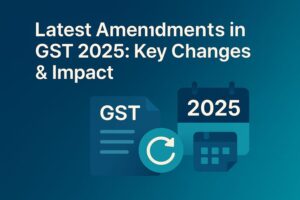Know the Types of Custom Duty after GST in India
- 24 Aug 24
- 11 mins

Know the Types of Custom Duty after GST in India
Key Takeaways
- Types of Duties: India imposes various customs duties including Basic Customs Duty (BCD), Countervailing Duty (CVD), Anti-Dumping Duty, Education Cess, and National Calamity Contingent Duty (NCCD).
- Calculation Basis: Calculation of Customs duty is based on the assessable value, which includes cost, insurance, and freight (CIF), along with applicable duty rates.
- Purpose: Custom duties aim to generate revenue, protect domestic industries, balance trade, prevent dumping, and ensure national security.
- Payment Methods: Custom duties can be paid online via the ICEGATE portal, making the process more efficient and transparent.
- E-Sanchit: This electronic platform allows for online submission of documents, reducing paperwork and speeding up customs clearance.
When it comes to international trade, custom duties play a crucial role in regulating the flow of goods. They are essentially taxes imposed on imports and exports by the government. Custom duties not only generate revenue but also protect domestic industries from foreign competition. In this article, we'll understand the various types of custom duties in India and it's significance.
What is Custom Duty?

Customs duty is a tax imposed on goods when they are transported across international borders. Its purpose is to protect each country's economy, residents, jobs, environment, and more by controlling the flow of goods, especially restrictive and prohibited goods, into and out of the country
Types of Custom Duties in India
India has a comprehensive structure for custom duties, each serving a specific purpose. Let's explore the different types:
1. Basic Customs Duty (BCD)
- A standard duty levied on imported goods to protect domestic industries from foreign competition and generate revenue. It is imposed under the Customs Act and varies depending on the type of goods and their classification under the Harmonized System (HS) codes.
2. Additional Customs Duty or Special Countervailing Duty (CVD)
- A duty equivalent to the excise duty levied on similar goods produced domestically.
- It aims to equalize the cost between imported goods and locally manufactured goods to ensure a level playing field. This duty is typically calculated based on the value of the goods plus the Basic Customs Duty.
3. Countervailing Duty (CVD)
- A duty imposed on imported goods that have received subsidies or incentives from their government.
- The goal is to counteract the unfair competitive advantage that subsidies to foreign producers provide, shielding domestic industries from subsidized imports.
4. Anti-Dumping Duty
- A duty imposed on imported goods sold below their normal value or below the cost of production.
- It is aimed at protecting domestic industries from predatory pricing practices by foreign exporters. The duty is typically calculated based on the margin of dumping, which is the difference between the export price and the normal value.
5. Education Cess
- An additional levy on the aggregate of customs duties to fund education initiatives.
- It is calculated as a percentage of the total customs duties payable and is used to support the government’s education programs.
6. National Calamity Contingent Duty (NCCD)
- A duty imposed to raise funds for relief and rehabilitation during national calamities.
- This duty is levied on specified goods and is used to finance recovery efforts and mitigate the impact of disasters.
7. Safeguard Duty
- A temporary duty imposed to protect domestic industries from a sudden surge in imports.
- It is intended to provide a breathing space for domestic producers to adjust and improve their competitiveness. The duty is usually applied for a limited period and reviewed periodically.
8. Protective Duty
- A duty imposed to protect specific domestic industries from foreign competition.
- It is generally higher than regular duties and is intended to shield emerging or vulnerable industries from competitive pressures until they become self-sufficient.
9. Social Welfare Surcharge on Imported Goods
- An additional surcharge levied on the aggregate of customs duties.
- The surcharge is meant to fund social welfare schemes and initiatives. It is calculated as a percentage of the total customs duties, excluding certain specified duties like safeguard duty and anti-dumping duty.
What is the Purpose of Custom Duty?
Custom duties serve multiple purposes, including revenue generation, protection of domestic industries, balancing trade, prevention of dumping, and national security considerations. Here are these purposes explained in detail:
1. Revenue Generation
- Custom duties are a significant source of revenue for the government.
- The revenue generated from custom duties helps fund various public services such as healthcare, education, and infrastructure projects. This steady stream of income is crucial for maintaining and developing public welfare and facilities.
2. Protection of Domestic Industries
- To protect local industries from foreign competition.
- By imposing duties on imported goods, the government can make these goods more expensive, thus encouraging consumers to buy domestically produced items. This protection helps ensure the growth and sustainability of local industries by preventing them from being undercut by cheaper foreign goods.
3. Balancing Trade
- To manage the trade balance by controlling imports.
- Custom duties help make imported goods more expensive, which discourages excessive imports and encourages the consumption of domestic products. This balancing act helps maintain a healthy trade balance, reducing trade deficits and promoting economic stability.
4. Prevention of Dumping
- To prevent foreign companies from flooding the domestic market with cheap products.
- Anti-dumping duties are imposed when foreign companies sell goods below their normal value or cost of production. These duties protect local manufacturers from unfair competition by ensuring that imported goods are sold at fair market prices, thus preventing market distortions and protecting domestic industries from being harmed.
5. National Security Considerations
- To control the import of goods crucial for national security.
- Custom duties can be used to regulate the import of products that are vital for national security, ensuring that critical industries do not become overly dependent on foreign sources. This measure helps maintain the integrity and independence of essential sectors, reducing vulnerabilities during conflicts or crises.
How is the Customs Duty Calculated?

Calculating customs duty on goods imported to India involves several steps. Here is a detailed guide on the process:
Step 1: Determine the Assessable Value of Goods
Assessable value is calculated by adding the cost of goods, freight charges, and insurance charges. Importers must provide an accurate value to avoid penalties and legal issues.
Step 2: Identify the tax Rates Applicable
Find out the applicable custom duty rates, which vary depending on factors such as:
- Type of Goods
- Classification under the Harmonized System of Nomenclature (HSN)
- Country of Origin
Consult the customs tariff schedule for specific rates.
Step 3: Calculate Basic Customs Duty (BCD)
Basic customs duty is computed as a percentage of the assessable value. It is levied on all imported goods. Refer to the customs tariff schedule to determine the BCD rate applicable to your goods.
Step 4: Calculate Additional Customs Duty (Countervailing Duty - CVD)
Additional customs duty, also known as countervailing duty, is applied to offset any subsidies or exemptions the goods might have received in the country of manufacture. This duty is equivalent to the excise duty on similar goods produced domestically.
Step 5: Calculate Education Cess and Other Cesses
Calculate the Education Cess (EC) and Secondary and Higher Education Cess (SHEC) on the total customs duty payable. This includes:
- Education Cess (EC)
- Secondary and Higher Education Cess (SHEC)
Additionally, calculate any other applicable duties such as:
- Anti-Dumping Duty
- Special Additional Duty (SAD)
- Safeguard Duty
Step 6: Consider Exemptions and Concessions
Importers may be eligible for exemptions or concessions on concessional duty depending on:
- Nature of the Product
- Applicable Trade Agreements
Rates of Customs Duty 2024 in India
| Category of Goods | Basic Customs Duty (BCD) | Additional Customs Duty (CVD) | Special Additional Duty (SAD) | Education Cess (EC) | Secondary and Higher Education Cess (SHEC) |
| Agricultural Products | 10% | 0% | 0% | 2% | 1% |
| Electronics (e.g., mobile phones) | 20% | 12% | 4% | 2% | 1% |
| Chemicals | 7.50% | 12% | 4% | 2% | 1% |
| Textiles and Clothing | 15% | 12% | 4% | 2% | 1% |
| Pharmaceuticals | 10% | 0% | 0% | 2% | 1% |
| Automobiles | 25% | 12% | 4% | 2% | 1% |
| Machinery and Equipment | 7.50% | 12% | 4% | 2% | 1% |
| Precious Metals (e.g., gold) | 12.50% | 0% | 0% | 2% | 1% |
| Food Products | 30% | 0% | 0% | 2% | 1% |
| Furniture Fittings | 20% | 12% | 4% | 2% | 1% |
Increase in Basic Customs Duty
In recent years, there has been an increase in basic customs duty on several goods to promote the "Make in India" initiative and reduce dependency on imports. This trend has significantly impacted various sectors, encouraging domestic production.
What is E-Sanchit?
E-Sanchit is an electronic storage and document management system introduced by the Indian Customs. It stands for "Electronic Storage and Computerized Handling of Indirect Tax documents." The system allows importers and exporters to submit documents online, thus streamlining the customs clearance process and reducing paperwork. Key features include:
- Electronic Submission: Importers and exporters can upload documents such as invoices, packing lists, and bills of lading electronically.
- Single Window Interface: It integrates with the Customs EDI (Electronic Data Interchange) system, enabling seamless processing and tracking of documents.
- Enhanced Transparency: Ensures that all stakeholders, including customs officials, can access the necessary documents, promoting transparency and efficiency.
How to Pay Customs Duty Online in India?

Paying customs duty online in India involves several steps, leveraging the digital platforms provided by the Indian government. Here’s how you can do it:
Step 1: Register on ICEGATE
- ICEGATE (Indian Customs Electronic Gateway): Visit the ICEGATE portal and register as a user. You will need to provide details such as PAN, IEC (Import Export Code), and other relevant information.
Step 2: Login to ICEGATE
- Use your credentials to log in to the ICEGATE portal. Ensure your profile is updated with the correct importer/exporter details.
Step 3: Access the Bill of Entry
- Bill of Entry: This document is required for customs clearance. You can file it electronically through ICEGATE. Ensure all details regarding the goods, including assessable value and applicable duty rates, are correctly entered.
Step 4: Calculate the Duty Payable
- Import Duty Calculation: Based on the assessable value of goods, calculate the Basic Customs Duty, Additional Customs Duty (CVD), Special Additional Duty (SAD), and other applicable cesses such as Education Cess and SHEC.
Step 5: Generate Challan
- Challan Generation: Once the duty amount is calculated, generate a payment challan through the ICEGATE portal.
Step 6: Make the Payment
- Online Payment: You can pay the customs duty using various online payment methods such as net banking, debit/credit cards, or through designated bank branches integrated with the ICEGATE system.
Step 7: Confirmation and Receipt
- Payment Confirmation: After successful payment of taxes, a receipt will be generated. This receipt is a crucial document for further customs processing and clearance.
Step 8: Submit Documents via E-Sanchit
- E-Sanchit Submission: Upload all required documents electronically through the E-Sanchit portal. This includes the payment receipt, Bill of Entry, invoices, and other relevant documents.
Conclusion
Custom duties in India are a critical component of the country's trade policy, serving multiple purposes from revenue generation to protecting domestic industries. Understanding the different types of custom duties and their implications can help businesses navigate the complex landscape of international trade more effectively.
💡If you want to pay your GST with Credit Card, then download Pice Business Payment App. Pice is the one stop app for paying all your business expenses.
 By
By 
















